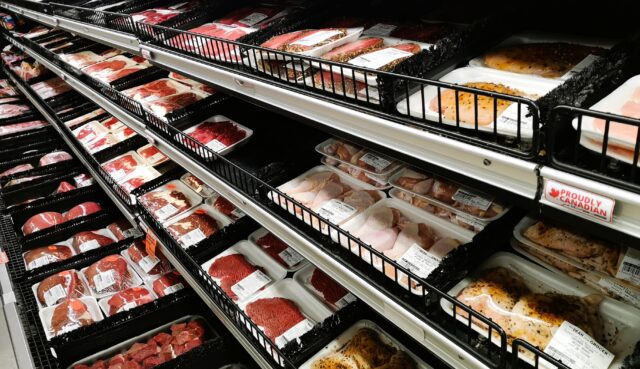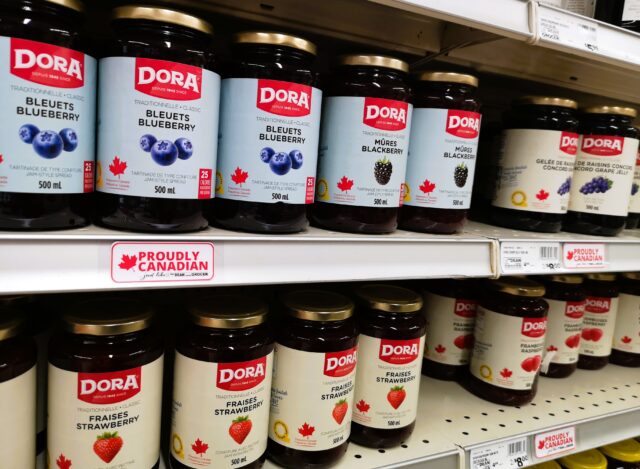Local grocer foregrounds Canadian foods

Gordon Dean describes his business as “the little mouse that runs around with a bunch of elephants.”
The metaphor refers to Mike Dean Local Grocer, the group of community-based grocery stores plying its trade on terrain dominated by giant corporate food operations the likes of which include Metro, Empire and Galen Weston Jr. and Loblaw Companies.
His father started the business in 1976 – Dean himself has been at it pretty much since he finished high school – and the Mike Dean brand has grown into five small-format rural-based grocery stores employing roughly 110 people.
Having visited many such small stores in a variety of communities, I found the Bourget Mike Dean’s warm and inviting – harkening to an earlier era where groceries were purchased at farmers’ markets or small stores set up in residential neighbourhoods.
The store is quaint, friendly and local. What I saw as I checked out the meat and produce sections and wandered the centre aisles was a food retailer that adds more value to the customer experience than any faceless corporate monolith in the big chains.

That sensibility has very likely increased several orders of magnitude since the “Buy Canadian – Bye American” movement of late.
Or has it? What Gordon Dean says, in fact, is that the Mike Dean approach hasn’t really changed – except for the sudden appearance of “Proudly Canadian” stickers on the shelves.
“Because of who we are and where we’re from, which is eastern Ontario and western Quebec, this isn’t a marketing gimmick,” Dean says. “It’s always been a reality that we’ve always delivered on. The only way we can stay relevant is to connect to our consumer.”
Just about immediately when the U.S president started his erratic squawking about tariffs, the store met the logistical challenge of identifying Canadian products, designed the stickers they wanted and had about 20,000 of them manufactured at a local printer (at no little cost) and then applied them to the shelves.
It is a nuanced distinction between “Product of Canada” and “Made in Canada,” Dean acknowledges – even as someone who has been in the business virtually his entire life.
“As a food retailer, I understand the supply chain better than the vast majority of Canadians, and it’s not always clear to me. It’s not going to be clear for customers.”
You might imagine some sort of master list or searchable computer database of products made in Canada or products made in the U.S. with Canadian ingredients.
But it doesn’t exist, according to Dean.
“The stickers went into our five stores within two or three days. We literally had a couple people in each store run the aisles, and we gave them pointers on what we wanted them on. There’s several very good Canadian companies we do a lot of business with and that support us very well. They got their tags first, and then we literally had to start looking at the backs of products to see who is claiming to be Canadian,” Dean says.

Within that bit of labelling space, if you might call it that, between “Product of” and “Made in,” the Mike Dean Local Grocer brand has taken an arguably defensible position: as long as the producer is a Canadian company who supports independent grocers like Mike Dean they got a sticker.
“We did not tag the big American companies who also produce product or make a product here. We could have, but we chose not to,” he says.
During a quick wander through the Bourget aisles, I was, frankly, surprised at the raw number.
To be sure, some customers don’t care about Canada flag stickers and shop based on price only: that’s understandable. While no store that I have visited has forced “Canadian” down a shopper’s throat, it is remarkable to see how habits have changed – dramatically and overnight. I can’t say if people sense an existential threat, but the shift has been obvious, agrees Dean.
“There’s absolutely traction on it. Even with the stickers or even if they know it’s a Canadian product, people are flipping products over to read the labels more than they ever have, to a noticeable point.”
Looking at the tidy and well-organized meat counter, it’s important to note that all the products – “100 percent, not 99 per cent,” Dean stresses – are Canadian-sourced and most from this part of the province. They even break down many of the cuts in-house each day and package it freshly.
“That’s not something we play with,” he adds. “We’re located in agricultural communities, and that’s our bread and butter. It would be illogical and irresponsible for me to sell American chicken or pork or beef when you sell groceries in small-town rural Ontario.”
I asked Dean if the stickers signify anything really new at his grocery stores when it comes to running the business in smaller communities: he says yes and no and seems to imply that the mouse is nimble around elephants.
“It’s business as usual with a big star beside the fact that we’re doubling down on it. There’s market instability, and there is going to be some ugliness in the big wide world, but as a rural Ontarian I actually see that there’s more opportunity than risk.”
Dean, based on his experience in the food industry, suggests that Canadians are in this together and need to change how we do food business and enliven markets and trade.
Retailers, manufacturers and customers, if they hold their resolve, will come out “the other side” having built a better Canadian and local food supply chain and stronger food production that has, he hopes, implemented exports and trade to more than a single large customer.
“There will be pain along the way, but the end result will be a stronger food-supply network. When this is all over with, we’re going to look in the rearview mirror and say these are steps we should have taken a long time ago.”

